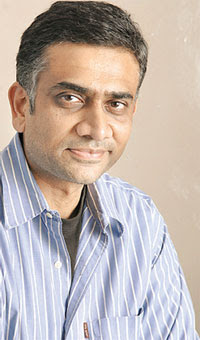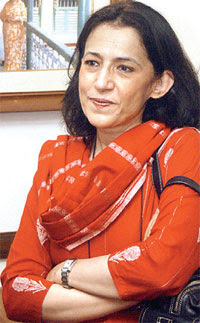Why it’s trendy to read Manto again
By Aasheesh Sharma
Hindustan Times July 25, 2014
“Upar di gur gur di annexe di bedhiyana di moong di daal of di Pakistan and Hindustan of di durr phitey mun”
This manic monologue mumbled by Bishan Singh in the short story Toba Tek Singh stays with you years after you’ve read Saadat Hasan Manto. Is it the same acidic narrator of Partition stories who, in his movie columnist avatar, holds forth elegantly on Sitara Devi’s charms and the reclusive ways of Ashok Kumar?

The tumult and the romance: Saadat Hasan and his wife Safia Manto in Bombay, circa 1947
The James Dean of India’s literary circles, Manto died in 1955, aged just 43. During his short and tumultuous life, he put out a body of work that challenged genres, almost deliriously churning out 22 collections of short stories, one novel, five collections of radio plays, three collections of essays, two collections of personal sketches and innumerable movie scripts. This included the story for Mirza Ghalib, the first Hindi film to win the National Award in 1954.
Two years after his birth centenary, there appears to be a revival in the tradition of Manto Shanasi, or Manto scholarship among English-speaking audiences. Still, VK Karthika, chief editor at HarperCollins Publishers India, would stop short of calling it a revival.
Also read: Adaptation of Saadat Hasan Manto’s Kaali Shalwar on stage
“Over the years, there have been other translations of Manto, particularly in Hindi. Perhaps the 100th anniversary spurred some additional interest in him in 2012,” says Karthika. “What may be changing is another aspect. For very long, we’ve read Manto so unquestioningly, seemingly putting him on a pedestal, that fresh readings of his work may provide an opportunity for re-thinking and recasting. The time may just be right for more reasoned discussions of what Manto’s work actually stands for,” says Karthika.
Between covers
Why I Write: Essays by Saadat Hasan Manto, edited and translated by Aakar Patel, Tranquebar Press, Westland (2014)
The Pity of Partition: Manto’s Life, Times, And Work across the India-Pakistan Divide, by Ayesha Jalal, HarperCollins India (2013)
My Name is Radha, stories translated by Muhammad Umar Memon, Penguin India, (2015)
Manto: Selected Short Stories translated by Aatish Taseer, Random House India (2012)
Stars from Another Sky, a collection of Manto’s Bombay writings, Penguin India (2010)
A disturbing influence
At times Manto’s writing created such savage imagery it ended up leaving you disturbed. Karthika recalls once such scene from Khol Do, where a teenage riot victim has been assaulted so many times that she undoes the cord of her shalwar in a reflex, when her father comes looking for her in a hospital room and the doctor says “Khol do,” referring to the windows. The storytelling itself is so impactful that the language and the form become secondary. Penguin India managing editor R Sivapriya says that it might be an appropriate time to pay a tribute to the literary Manto, as opposed to the Partition Manto or the Bombay Stories Manto.
“The interesting thing is that he is being published in translation journals such as Words without Borders,” adds Sivapriya.
Born in a family of Kashmiri barristers who had settled in Punjab in 1912, Manto studied at Amritsar’s Muslim High School but was miserable at academics, failing in Urdu at the matriculation stage. But destiny had bigger plans for him.
Also read: Manto's 'Intzaar' staged in India
Manto’s grandniece Ayesha Jalal, professor of History at Tufts University, says notwithstanding his misleading characterisations by officialdom, Manto has always had an ardent following in Pakistan. “I think his Partition writings have the same sort of impact on literary connoisseurs in Pakistan as anywhere else in the world,” she says, though she adds that “he continues to have his detractors who insist on portraying his realistic depictions of the human dimension of Partition as ‘obscene’.” Even while he was still alive, Manto invited numerous charges of obscenity and was tried for his short stories, on both sides of the border: most famously for Boo, Khol Do and Thanda Gosht.
Maximum chronicler
For more than a decade, between 1936 and 1948, Manto worked in Bombay’s film industry, creating scripts, magazine articles and short stories.
A selection of his film writings was published by Penguin as Stars from Another Sky: The Bombay Film World of the 1940s, in 2010. “Manto’s film writing is gossipy, rich in detail and sharply insightful in his typically elliptical fashion. It will be sly well-placed observation that cracks open the piece for you,” says Sivapriya.
The storyteller’s new relevance among the English-speaking classes, avers Aatish Taseer, could be a reflection of how culturally denuded the world of English in India is. “One longs for a voice with Manto’s urgency, his ability to deal directly with his material, his nearness to his world. Manto’s Bombay and Punjab even now feel like places one recognises; there is nothing of the isolation of the Indian-English writers,” says Taseer.
Also read: In his daughters, Manto returns home
Journalist Aakar Patel contends that no writer, either before or after him, not even Behram ‘Busybee’ Contractor, ‘got’ Bombay as well as Manto did. Patel attributes this to two reasons.
“First, Manto nails what Bombay means to the outsider. As a writer he was secure only here. Second, he understands how important Mumbai is to the sub-continent. Popular entertainment can only be produced on the cusp of obscenity. That is why Iran and Pakistan produce art but not entertainment. Bombay, with no dominant community or culture, with its British influences, with its mercantile ethic, gave writers and filmmakers that liberal space in Manto’s time.It was a free city. And he revelled in this freedom.”

Brilliance in shadows
The shadowy world of society outcasts was what fascinated Saadat Hasan Manto the most. Ismat Chugtai once said about him that Manto picked out pearls “from the jilted squalor and refuse of life.” Drawn to the dark side, the writer took his readers with him into the noir worlds of prostitutes, pimps, waifs, wastrels and debauchees.
But his genius was never in doubt. That is why, when Salman Rushdie called him the undisputed master of the modern Indian short story, his legion of admirers in the subcontinent, the Manto-nafees, were not surprised.
In 2015, it will be 60 years since Manto died of cirrhosis of liver. That is also the year when the copyright on his works goes into the public domain, so expect a slew of new translations. Patel is looking forward to it. “What I would like is for Manto’s entire works – there are seven volumes in Urdu – to be transliterated, in Devnagari and also in Roman Urdu (meaning the English alphabet). Manto thought Hindi and Urdu were the same and laughed at those who emphasised the differences.”
THE STORYTELLER

Aakar Patel, Editor and translator of Why I Write: Essays by Saadat Hasan Manto
“His daughter Nighat told me that till the 1980s, she had no idea what a big writer her father was. Why is he still around when everyone else from his time is in a museum? He was a modern writer, more modern than Indian writers are even today in 2014.”
Why Manto: His short stories. In Bu, a man is intoxicated by the scent of a peasant woman’s armpit. I read it in translation in Debonair when I was 13. I had not ever read something so sensual that was so Indian.

Aatish Taseer, Translator of Manto: Selected Stories
“When I returned to India, I wanted to hear literary voices –in the original, where possible – from the geographical area in which I was operating as a writer. It was in this context that I was thrilled to have discovered Manto.”
Why Manto: The influence of Maupassant is visible everywhere. And such range! He made it possible for me to imagine the Forties in India.

Ayesha Jalal, Manto’s grandniece, writer of The Pity of Partition: Manto’s Life, Times and Work across the India-Pakistan Divide
“I like the anecdote in Ganje Farishtay about Ashok Kumar driving Manto home and negotiating his way through a rough Muslim-dominated area of the city following the outbreak of partition violence.”
Why Manto: His literary corpus cannot be confined to the national paradigms of either India or Pakistan. Saadat Hasan Manto can’t be appropriated by one nation alone.